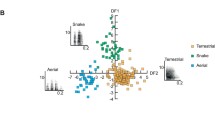Summary
-
1.
The alarm calls of the Gunnison's prairie dog, Cynomys gunnisoni zuniensis, have differentiated into local dialects.
-
2.
Call characteristics show that, within a given dialect, the number of syllables, the length of the syllables, and the interval length between syllables are weakly correlated with one another. The number of syllables, however, is strongly correlated with the total length of the call.
-
3.
Both the number of syllables and the total call length are strongly correlated with the complexity of the habitat: the more complex the habitat in terms of vegetation cover, rocks, and tree stumps, the more syllables there are and the longer is the call. This may be related to predation pressure, with prairie dogs in more complex habitats calling longer to warn their kin when a predator approaches.
Similar content being viewed by others
References
Baker MC (1975) Song dialects and genetic differences in white-crowned sparrows (Zonotrichia leucophrys). Evolution 29:226–41
Baptista LF (1975) Song dialects and demes in sedentary populations of the white-crowned sparrow (Zonotrichia leucophrys nuttali). Univ Calif Berkeley Publ Zool 105:1–52
Green S (1975) Dialects in Japanese monkeys: vocal learning and cultural transmission of locale specific vocal behavior? Z Tierpsychol 38:304–314
King JA (1955) Social behavior, social organization, and population dynamics in a black-tailed prairie dog twon in the Black Hills of South Dakota. Contrib Lab Vertebr Biol Univ Mich 67:1–126
LeBoeuf BJ, Peterson RS (1969) Dialects in elephant seals. Science 166:1654–1656
Marler P, Tamura M (1962) Song ‘dialects’ in three populations of white-crowned sparrows. Condor 64:368–377
Morton ES (1975) Ecological sources of selection on avian sounds. Am Nat 109:17–34
Nottebohm F (1969) The song of the chingolo, Zonotrichia capensis, in Argentina: description and evaluation of a system of dialects. Condor 71:299–315
Owings DH, Virginia RA (1978) Alarm calls of California ground squirrels (Spermophilus beecheyi). Z Tierpsychol 46:58–70
Poole RW (1974) An introduction to quantitative ecology. McGraw-Hill, New York
Potemkin JR (1976) Aggression and territoriality in the Zuni prairie dog, Cynomys gunnisoni zuniensis. Am Soc Mammal 56th Annu Meet, Lubbock, Texas
Sherman PW (1977) Nepotism and the evolution of alarm calls. Science 197:1246–1253
Smith RE (1958) Natural history of the prairie dog in Kansas. Univ Kans Mus Nat Hist Misc Publ 16:1–36
Smith WJ, Smith SL, Oppenheimer EC, Devilla JG (1977) Vocalizations of the black-tailed prairie dog, Cynomys ludovicianus. Anim Behav 25:152–164
Somers P (1973) Dialects in southern Rocky Mountain pikas, Ochotona princeps (Lagomorpha). Anim Behav 21:124–137
Waring GH (1970) Sound communication of black-tailed, white-tailed, and Gunnison's prairie dogs. Am Midl Nat 83:167–185
Wiley RH, Richards DG (1978) Physical constraints on acoustic communication in the atmosphere: implications for the evolution of animal vocalizations. Behav Ecol Sociobiol 3:69–94
Author information
Authors and Affiliations
Rights and permissions
About this article
Cite this article
Slobodchikoff, C.N., Coast, R. Dialects in the alarm calls of prairie dogs. Behav Ecol Sociobiol 7, 49–53 (1980). https://doi.org/10.1007/BF00302518
Received:
Accepted:
Issue Date:
DOI: https://doi.org/10.1007/BF00302518




